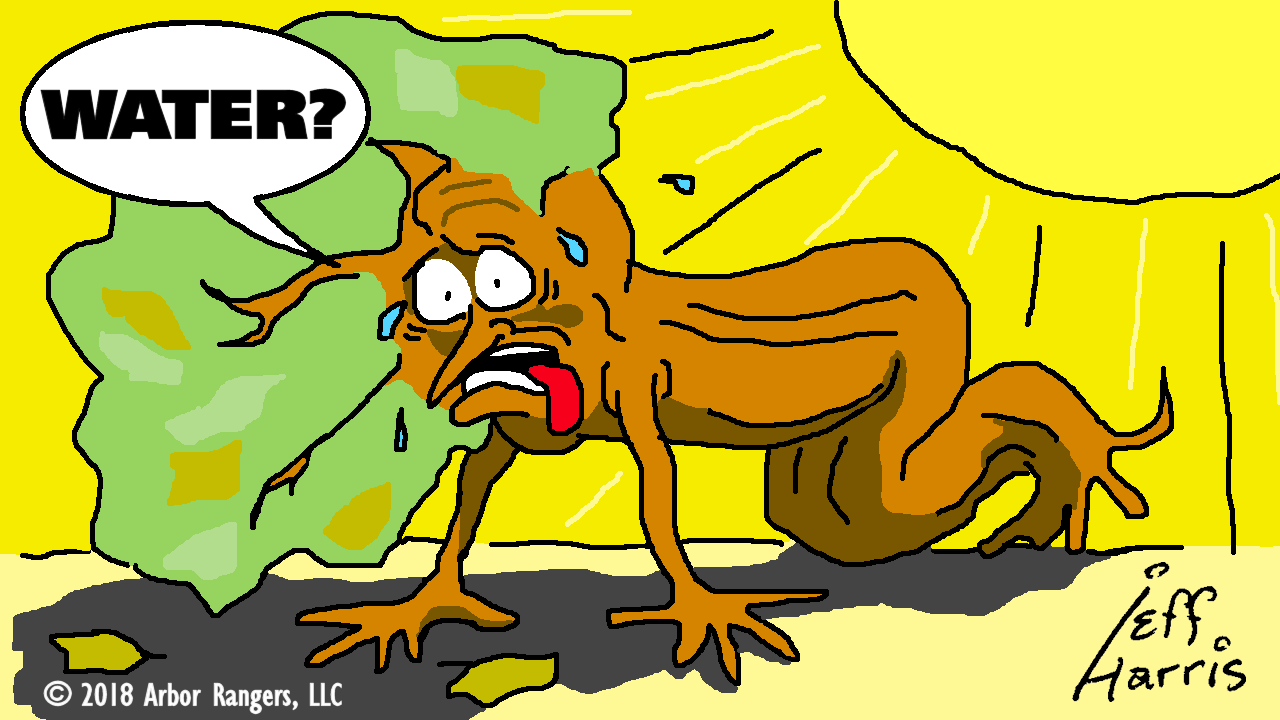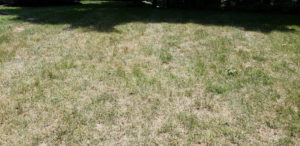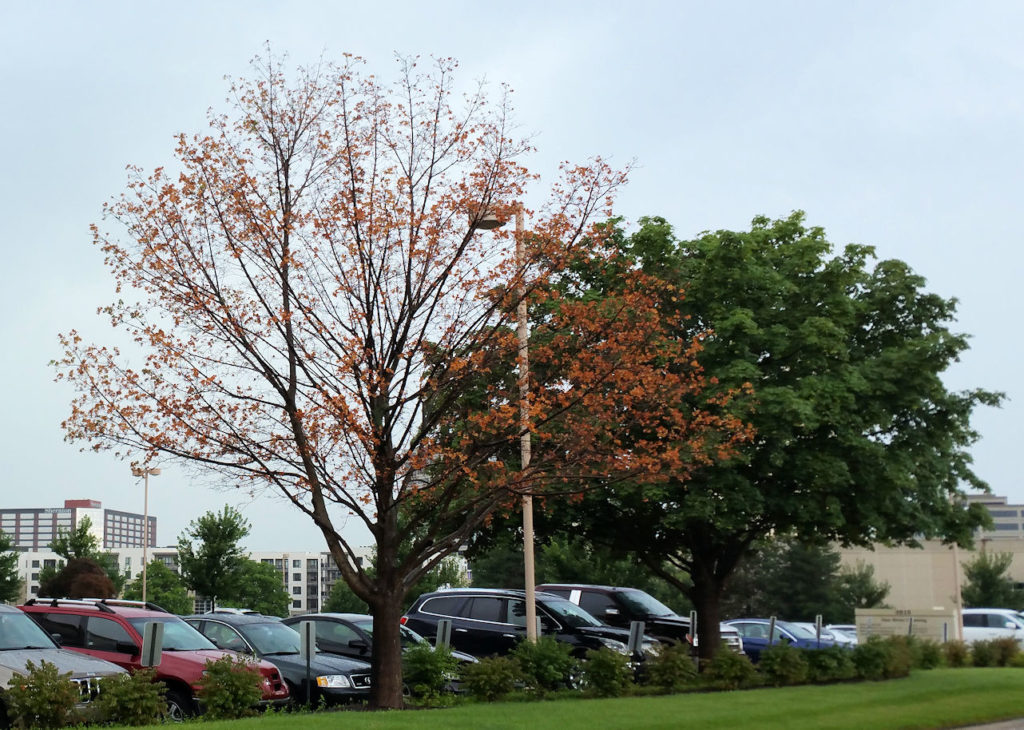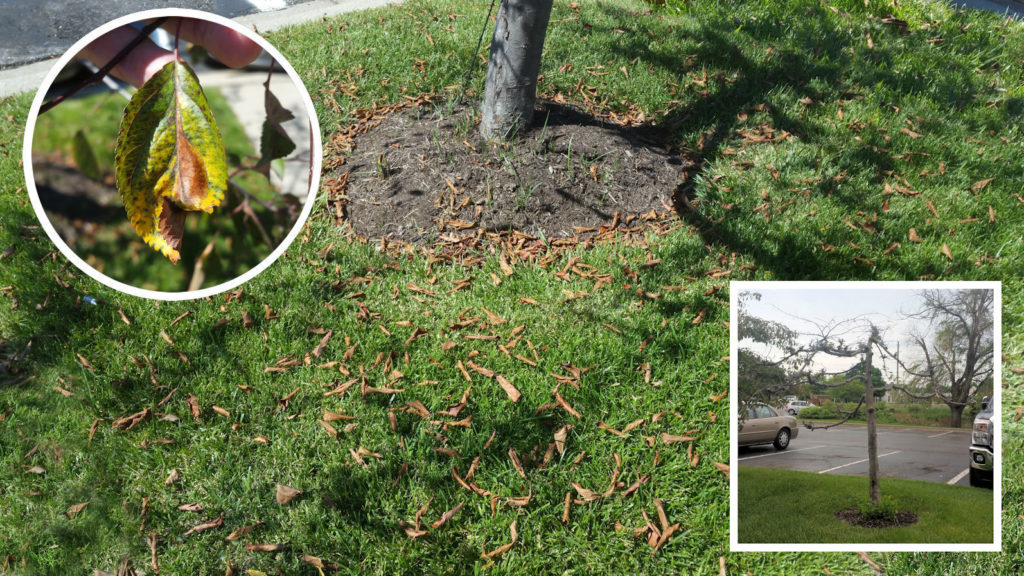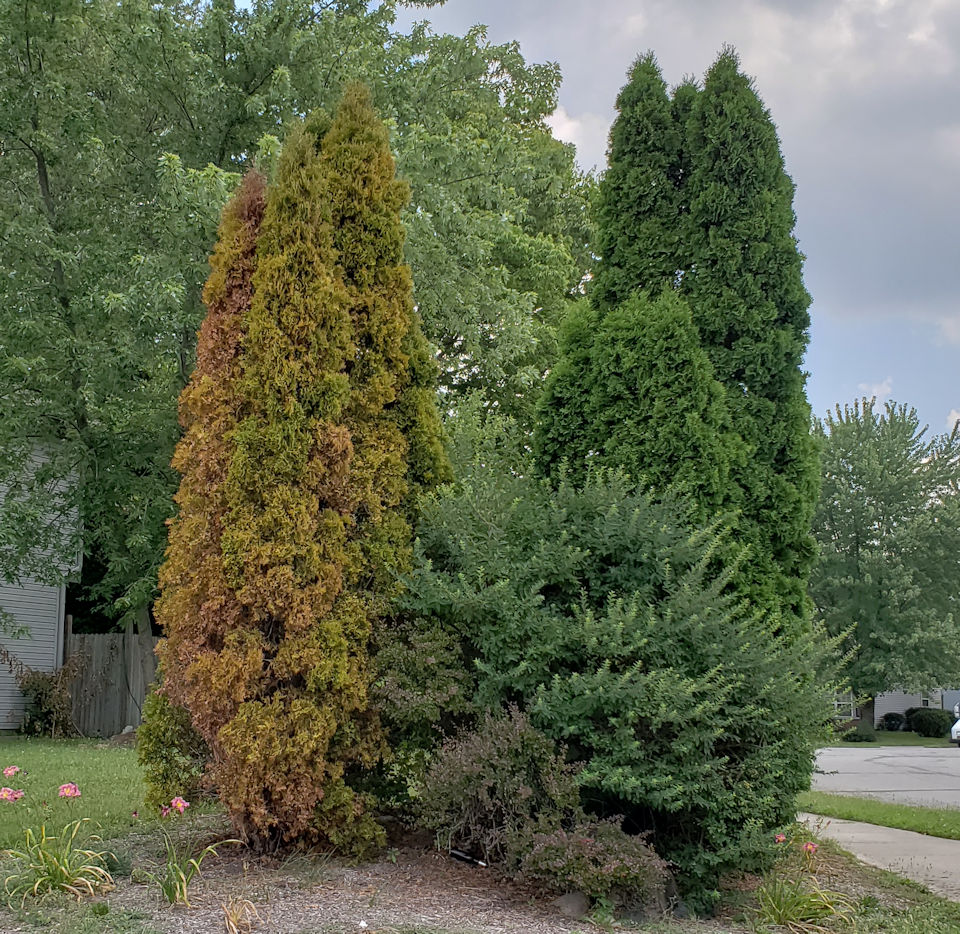[Last update: November 2025]
Quick Links to Topics Covered in This Article:
INTRODUCTION • Dessication Stress Death: “Sudden Death”
Water is the Best Medicine • Be Proactive
Should I Fertilize My Trees? • Unseasonal Heat Trends
INTRODUCTION
HEAT & DROUGHT STRESS can negatively impact your landscape plants, particularly your trees. The photo below is from an actual irrigated lawn following several heatwaves. Despite receiving water from an irrigation system, the greenest areas of the lawn were those that were “protected” from sun exposure by shade trees most of the day. The rest of the lawn, on the other hand, was drying out. For many homeowners, a “weed-free” green lawn is a priority. They will invest in an in-ground irrigation system with the primary goal of their lawn’s success (and their trees only as an afterthought). Perhaps, they reason that ‘trees are big enough plants and can take care of themselves!‘ Unfortunately, when it comes to their existence in our urban settings, that is furthest from the truth!
If you have an irrigation system and your lawn looks like this…
Just think about how much your trees are suffering!
Did you know that turfgrass, with or without an irrigation system, can survive a period of prolonged high heat and drought by going into dormancy? Many types of turfgrass can do this with little residual side effects other than a browned appearance, thinning, and yielding space to more tolerant weeds. Once climate conditions become more moderate with sufficient water, turfgrass will be restored and produce green shoots once more.
For additional information on recommended grasses for Midwest Lawns and drought recovery, see:
- Low Maintenance Lawns in the Midwest (Michigan State University Extension)
- Purchase Quality Grass Seed For Your Lawn (Purdue Extension & University of Illinois Extension)
- Dealing with Drought (Purdue Extension)
On the other hand, the same restorative response does NOT hold true with trees!
The Red Maple (Acer rubrum) below died in 2017 following 2016’s severe drought conditions. As you can see, the plants surrounding the maple appear healthy, and it itself has produced foliage during the current season. Sadly, despite being in an irrigated area, it did not survive long into the season when the summer’s heat got the better of it. (Note: It had grown successfully for years along with other maples in a business park, but it was the only tree in the row of maples that did not survive. Girdling roots (which restricted some of its ability to transport sufficient amounts of water from its roots) contributed significantly to its rapid decline.)
Although harsh conditions will indeed initiate a “shutdown” process, such as the closing of leaf stomata (to prevent water vapors from escaping, thus reducing moisture loss), leaf abscission (leaf drop), cladoptosis (shedding off of limbs), and reduction of root biomass, the hydration needs of trees are nonetheless far more complex than turfgrass. The volume of water needed to sustain trees plays a critical part in their survival. The longer a tree must endure high heat and drought without proper hydration, the more residual damage will occur to its biological system.
And so, even if certain plants appear to have escaped the “Grim Reaper” this year, this does not mean they weren’t affected by the harsh climate conditions. Decline and even death in some trees can occur either suddenly, slowly, or on a “biological” delay. Symptoms of decline, such as stunted growth and dieback, may not become noticeable until the following year, and symptoms may increase over the next several years.
DESSICATION STRESS DEATH: “SUDDEN DEATH“
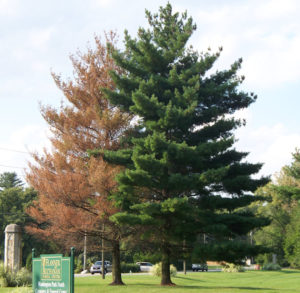
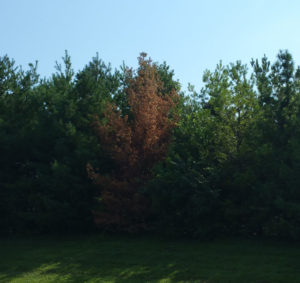

“Sudden death” is a term we use to describe the situation of a tree that looks fine one day and then suddenly dies (within hours, days, or a few short weeks) following a significant thermal climate event, such as a heatwave, and is characterized by wilted & browned leaves that are still firmly attached to their twigs. This phenomenon is sometimes referred to as Dessication Stress Death. This rapid dehydration causes cell damage and death that outpaces the normal process of leaf abscission, leading to leaves remaining attached while the plant dies. This is distinct from typical seasonal senescence, which is a more gradual, hormonally regulated process of aging and nutrient recovery before leaf drop.
It is also not uncommon for a tree planted among its own species to seemingly die at random and for no apparent reason. This scenario is known as Differential Mortality and may occur even when all conditions seem to be the same. The underlying cause is that some trees are simply less resilient to stress than their neighbors. A single tree can succumb to multiple interacting factors that eventually overwhelm it, while its stronger neighbors endure. This process is sometimes referred to as the Dieback-Decline Complex, as trees undergo a gradual decline in vigor before dying. Insufficient water, poor root establishment, girdling roots, and improper transplanting, which may be exacerbated by a localized drought, poor drainage, or nutrient deficiency, secondary organisms (e.g., pests and diseases), genetic variability, etc., are leading contributors to sudden death.
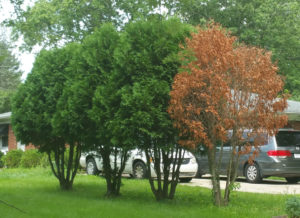
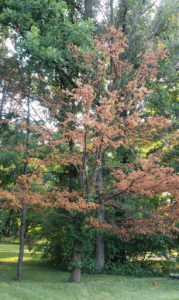

The weaker or sicker an unmanaged tree is, the more likely it will succumb to heat & drought stress. As mentioned earlier, trees with girdling roots will have a very tough time keeping up with their hydration needs because the girdling is literally strangulating the lower trunk stem above, at, or below the root crown (a.k.a. trunk flare, root flare), restricting the flow of nutrients and life-saving waters drawn from the root system. (See “Girdling Roots – The Silent Tree Killer”)
In the Indianapolis (Indiana) area, 2018’s unseasonably hot climate began early in the spring and has become a recurrent theme ever since (as of 2025). Many Hoosiers have joked that we never had a spring this year, but jumped straight from winter into summer! Lindsey Purcell, the Urban Forest Specialist at Purdue University in West Lafayette, IN, humorously coined the phrase “Sprinter” to describe how winter melded almost seamlessly into spring and went straight into summer! A few years ago, Lindsey wrote an excellent publication on the subject of drought. which we highly recommend you download, read, and keep handy. The PDF of this publication is available here: “Drought? Don’t Forget the Trees!”
The repetitive heatwaves have pushed even healthy plants to their limits! Ornamental landscape plants with even the slightest ailments are having even more difficulty coping with the heat! You may have noticed that some trees have already lost many of their leaves. Some of these trees may have nonlethal diseases, such as Apple Scab on Flowering Crabapples (see photo below), Powdery Mildew on Sycamores, Anthracnose on Ash trees, Tubakia Leaf Spot on Oaks, etc.) or insect feeding injuries caused by Japanese Beetles on Lindens, Eastern Tent Caterpillars on Crabapples, Aphids on River Birches, White Pine Weevils on Conifers, etc. These plant health problems (along with many others) combined with the unseasonably high heat, can make ailing trees appear extra “ugly” due to increased defoliation. Diseased and insect-damaged leaves tend to dry out quickly, turn “extra-crispy” and drop earlier than normal throughout the spring and summer seasons. This was especially true for Indianapolis trees when temperatures lingered above 85°F into the 90s over several days. Not too surprisingly, many ill trees died.
Apple Scab (Venturia inaequalis) is a fungal leaf spot disease (see circle inset) that causes premature leaf abscission in Malus spp. trees. Leaf loss is more profound and severe when it is exposed to prolonged periods of intense heat and drought conditions. Eventually, the crabapple succumbs and dies (square inset) because its roots were also “bound” from improper planting years ago.
Watering according to a plant’s needs, however, is still the best medicine. You don’t have to water every day, but if you do water, please make sure it’s a good, deep soak to encourage deeper growing roots. Shallow watering usually only encourages shallow, less drought-tolerant roots, and so during periods of high heat and drought, shallow roots are the first to dry up and may eventually die. What is your contingency plan? Don’t wait until the heat is upon you. Have a plan in place and ready. Your trees are counting on you! (See our article “Watering Trees – How Much?“)
BE PROACTIVE
How can you protect your landscape from heat and drought? Well, aside from transplanting your trees properly and ensuring they get enough water, another way is to simply pay close attention to drought trends. Keep updated on the latest weather reports and forecasts, and, if you’re really ambitious, look up historical weather data to draw timeline comparisons. It’s nearly impossible to predict the weather with 100% accuracy (because sometimes relying on weather forecasts can be a game of roulette), but by combining resources, you’ll discover clues that can prepare you to manage the needs of your plants so that they receive adequate supplies of life-sustaining water during the hot & dry seasons.
To check soil moisture, use a screwdriver (over 8″ long) to poke into the soil. If the soil is moist, it should pass easily through it, but if the soil is too dry and you can’t push the screwdriver into it at least 6″ deep, then it may be time to water (or maybe, you have some very rocky soil!). A handy tool to have is a Soil Moisture Meter (SMM). A SMM is a probing device that you insert about 4-6 or more inches into the soil. Its display will give you a general idea of whether your soil ranges from dry to moist to wet. Examples of simple SMM can be found on Amazon’s website.*
Performing some plant health care (PHC) treatments in temperatures above 85°F may put a plant at greater risk of phototoxicity, “leaf burn” from phototoxicity, and additional plant stress from phototoxicity. Poor timing, choice of chemicals, application method, and rates used are some of the main factors that may influence a less-than-desirable result. PHC treatments might include applying fertilizers (usually to address nutrient deficiencies) during high temperatures, managing diseases & controlling insect infestations late after infection/infestation has already caused significant plant injury, etc. In the case of fertilizers applied to an already stressed plant, there is a risk that these plants could run out of energy while trying to metabolize the nutrients fed to them. Additionally, these mineral “salts” can cause a drying effect (a.k.a. reverse osmosis) and deprive the plant of vital moisture. So use caution because applying supplemental fertilizers on stressed trees may do far more harm than good! It is imperative as a best management practice to read product labels in their entirety and to follow their directions exactly to minimize plant injuries, to maximize results, and in certain cases, to stay in compliance with the Law. (Related articles: “Leaf Scorch” and “Why Does Over-Fertilization Kill Plants?”)
*Please Note: SMMs are not 100% accurate, and can vary in quality and features depending on their manufacturer. These still can be useful devices in indicating watering needs. The mention of trade names or commercial products in this article is solely for the purpose of providing subject matter-related examples and does not represent, imply, or constitute an endorsement of one brand over another. Arbor Rangers, LLC, or its associates, do not warrant, nor guarantee results by use of any specific name-brand product in addressing your specific needs. This article may contain pesticide, equipment, and/or product type recommendations that are subject to change at any time. The recommendations are provided only as a guide.
The following chart shows the unseasonably high temperatures that popped up and lingered near the end of spring and into summer in the Indianapolis area from May 15, 2018 – July 19. 2018. Included for comparison are historical averages from the National Weather Service and high temperatures recorded from 2017.
2018 OVERVIEW OF UNSEASONABLE HEAT TRENDS (Indianapolis, IN) May 15 – July 19
As you will see from the chart below, this year Indianapolis has experienced unseasonably HOT temperatures (highlighted in yellow) and very little precipitation (highlighted in blue). Compared to last year’s temperatures, which started out unseasonably high but then registered closer to the historical averages (notable exceptions highlighted in orange), this year will definitely have a tremendous (and devastating) effect on landscape plants over the next few years.
|
DATE |
2018-HI°F |
Weather Condition |
NWS-AVG°F** |
Notes |
2017-HI°F |
|
5/15 |
75 |
overcast |
72 |
83 |
|
|
5/16 |
74 |
light rain |
72 |
84 |
|
|
5/17 |
84 |
overcast |
72 |
83 |
|
|
5/18 |
72 |
light rain |
73 |
85 |
|
|
5/19 |
79 |
overcast |
73 |
81 |
|
|
5/20 |
84 |
scattered clouds |
73 |
78 |
|
|
5/21 |
79 |
thundershowers |
74 |
74 |
|
|
5/22 |
83 |
scattered clouds |
74 |
71 |
|
|
5/23 |
82 |
passing clouds |
74 |
73 |
|
|
5/24 |
83 |
passing clouds |
75 |
64 |
|
|
5/25 |
88 |
passing clouds |
75 |
Unseasonable High Temps |
64 |
|
5/26 |
88 |
partly sunny |
75 |
|
78 |
|
5/27 |
90 |
partly sunny |
76 |
|
79 |
|
5/28 |
94 |
partly sunny |
76 |
|
77 |
|
5/29 |
88 |
partly sunny |
76 |
|
82 |
|
5/30 |
79 |
partly sunny |
77 |
76 |
|
|
5/31 |
88 |
passing clouds |
77 |
Unseasonable High Temps |
78 |
|
6/1 |
85 |
partly sunny |
77 |
|
79 |
|
6/2 |
88 |
partly sunny |
77 |
|
83 |
|
6/3 |
81 |
passing clouds |
78 |
85 |
|
|
6/4 |
77 |
passing clouds |
78 |
87 |
|
|
6/5 |
86 |
passing clouds |
78 |
Unseasonable High Temp |
87 |
|
6/6 |
79 |
passing clouds |
79 |
78 |
|
|
6/7 |
90 |
scattered clouds |
79 |
Unseasonable Severe Temps |
71 |
|
6/8 |
90 |
light rain |
79 |
|
76 |
|
6/9 |
85 |
scattered clouds |
79 |
|
83 |
|
6/10 |
70 |
light rain |
80 |
84 |
|
|
6/11 |
75 |
rain |
80 |
87 |
|
|
6/12 |
77 |
overcast |
80 |
90 |
|
|
6/13 |
86 |
partly sunny |
80 |
Unseasonable High Temp |
85 |
|
6/14 |
81 |
scattered clouds |
81 |
90 |
|
|
6/15 |
85 |
scattered clouds |
81 |
|
81 |
|
6/16 |
91 |
scattered clouds |
81 |
Unseasonable Severe Temps |
86 |
|
6/17 |
91 |
scattered clouds |
81 |
|
86 |
|
6/18 |
91 |
scattered clouds |
81 |
|
81 |
|
6/19 |
91 |
thundershowers |
82 |
|
81 |
|
6/20 |
84 |
partly sunny |
82 |
83 |
|
|
6/21 |
75 |
light rain |
82 |
88 |
|
|
6/22 |
76 |
partly sunny |
82 |
84 |
|
|
6/23 |
73 |
partly sunny |
82 |
77 |
|
|
6/24 |
84 |
scattered clouds |
82 |
77 |
|
|
6/25 |
76 |
overcast |
82 |
76 |
|
|
6/26 |
75 |
thundershowers |
83 |
74 |
|
|
6/27 |
83 |
partly sunny |
83 |
74 |
|
|
6/28 |
85 |
partly sunny |
83 |
Higher Than Normal Temps |
80 |
|
6/29 |
90 |
scattered clouds |
83 |
|
87 |
|
6/30 |
90 |
scattered clouds |
83 |
|
85 |
|
7/1 |
93 |
scattered clouds |
84 |
|
84 |
|
7/2 |
87 |
partly sunny |
84 |
|
85 |
|
7/3 |
90 |
partly sunny |
84 |
|
87 |
|
7/4 |
93 |
scattered clouds |
84 |
|
87 |
|
7/5 |
90 |
scattered clouds |
84 |
|
85 |
|
7/6 |
82 |
scattered clouds |
84 |
84 |
|
|
7/7 |
82 |
sunny |
84 |
89 |
|
|
7/8 |
84 |
passing clouds |
84 |
80 |
|
|
7/9 |
91 |
scattered clouds |
84 |
Higher Than Normal Temps |
83 |
|
7/10 |
91 |
partly sunny |
84 |
|
84 |
|
7/11 |
87 |
scattered clouds |
84 |
|
79 |
|
7/12 |
85 |
partly sunny |
84 |
|
90 |
|
7/13 |
91 |
sunny |
84 |
|
84 |
|
7/14 |
93 |
partly sunny |
84 |
|
83 |
|
7/15 |
88 |
partly sunny |
84 |
|
81 |
|
7/16 |
88 |
partly sunny |
84 |
|
85 |
|
7/17 |
88 |
passing clouds |
84 |
|
87 |
|
7/18 |
84 |
scattered clouds |
84 |
88 |
|
|
7/19 |
84 |
partly sunny |
84 |
88 |
**National Weather Service Historic Daily Avg Temperature.
- Heat Wave Watering Alert! (Although written for Californians, this contains great principles for us in the Midwest)
- Drought Impacts Trees for Years to Come
- Scorch, Sunburn and Heat Stress (in Trees)
- How to Protect Your Trees and Plants From Heat, Drought Damage (Daily Herald (Chicago) article)

